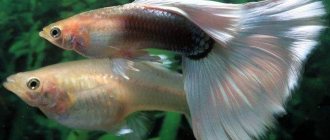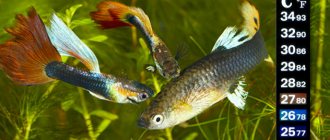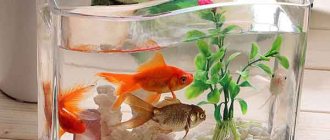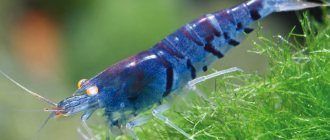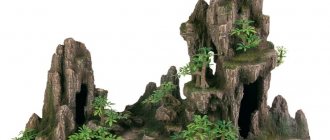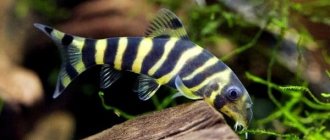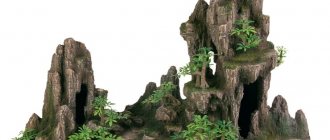The process of domestication of wild nature many centuries ago also involved the inhabitants of freshwater bodies. The first mention of artificial fish breeding dates back to 1500 BC. It all started in China, where they began to breed ornamental fish for keeping in small outdoor pools or aquariums. But every aquarist wanted to have the most beautiful aquarium fish.
Over time, the painstaking work of scientists and amateur aquarists on selection and hybridization led to the emergence of new breeds of ornamental fish. In all this diversity, it is difficult to choose the brightest and most attractive, but we will try, and here we have the most beautiful aquarium fish.
1
Astatotilapia burtoni
One of the species of ray-finned fish with a very original body color. They are mostly found with a gray or reddish-yellow color, but the sides have a blue, green or purple sheen.
Fish can be kept in an aquarium with other similar fish, but it is necessary to provide shelters for the females. Males of Astatotilapia burtoni, except during the spawning period, behave aggressively.
2
Other expensive and tropical fish
The golden basslet is also a grouper. The high price is due to difficult catching and transportation. Cost about $8,000.
Arapaima is the largest freshwater fish, with an average length of 2 meters. Arapaima 1.5 meters long are on sale for $950. You need an aquarium with a volume of at least 4 thousand liters.
Tetradon mbu - this fish lives in Africa, body length is up to 40 cm. It is aggressive; in case of danger, the fish swells into a ball. The average price for tetradone mbu is $790.
Tiger catfish merodontodus is distinguished by its bright color of black and white stripes. Body length up to 70 cm. Price starts from $800.
Tropical fish are also often kept in the aquarium. The following species are found: neon, swordtail, guppy, corydoras, black tetra, zebrafish, cherry barb, otocinclus catfish, harlequin rasbora, coral platy, transparent shrimp, beta fighting fish (cockerel).
We recommend reading
What to feed betta fish
Pink Danio (Danio rerio)
A very popular fish among aquarists, it belongs to the carp family. Due to the original color and body structure, this type of fish is also called “ladies’ stocking”.
Active, nimble fish will add cheerfulness and optimism to your aquarium. In science, zebrafish is a model organism on which many biological processes are studied.
3
Betta fish (Betta splendens)
A small, nimble fish from the macropod family is also called the Siamese cockerel.
Thanks to its complex organ, betta fish can breathe atmospheric air, so they hardly need aeration of aquariums.
Due to the pugnacious nature of the males, who were used in tournament battles, the ornamental fish received its main name.
4
Veiltail
A beautiful aquarium fish that differs from others with its tail. This is the most famous variety of goldfish. She has a small, short head that smoothly transitions into a rounded body. The tail, resembling a veil, is quite long and can exceed the size of the fish several times. It is milked and falls down in folds. The veiltail can have different colors. The most common is gold or red. They can also be black, white, pinkish or spotted. The veiltail is an ornamental fish and is not found in nature. In an aquarium they need water with a high oxygen content. Temperature can vary from 12 to 28 degrees. The fish are not picky when it comes to food; they can eat plant and meat foods, as well as dry food.
Veiltail (Carassius gibelio forma auratus)
Artificially bred fish are considered one of the most beautiful breeds of aquarium fish. The Queen Goldfish has elongated fins and an amazing veiled tail.
This species of fish was brought to the United States from Mikado Gardens in Japan. In difficult conditions, we managed to preserve the original breed, and now the price of these fish is very high and unique specimens are sold on an individual order.
6
Arowana
It is very interesting to watch the arowana. The fact is that to catch insects, the fish jumps out of the water. The behavioral feature explains the position of the fish's eyes, which are located on the top of the head. The price for a graceful fish starts from 10 thousand dollars. Therefore, for most it remains a dream. There are cases where rich owners performed operations on fish to correct eye defects. Such deviations in vision are explained by the fact that the fish catches food in the water column. Many who have seen her live note her hypnotic effect on a person.
Guppy (Poecilia reticulata)
Another very popular and well-known fish in the aquarium community.
In 1886, scientist Robert Guppy spoke before the Royal Society and spoke about a small viviparous fish. So these little fish got their name from the scientist.
Remarkably, small guppies are the first aquarium inhabitants to travel to space.
By the way, there is a very interesting article on most-beauty.ru about the most amazing things that were found in space.
7
Pearl gourami (Trichogaster leerii)
The silvery body of this labyrinthine fish is decorated with evenly distributed pearlescent spots.
With the help of an original organ called a “labyrinth” they can breathe atmospheric air. Without access to the surface of the water for a long time, gouramis die.
A very peaceful and very shy fish appeared among Russian aquarium lovers in 1947 and is now one of the most popular ornamental breeds.
8
Unusual aquarium fish
In this chapter we will look at several different fish, quite rare and expensive, but of interest to the aquarist and adding an unusual exotic charm to the home pond.
“Chinese policeman” is the name that has not yet taken root for a new magnificent fish from China, one of the latest acquisitions of the world aquarium hobby, the Asian myxocyrinus, or “Chukchan”, or “Frigate” (Myxocyrinus asiaticus) . The unusual shape of this still rare and expensive fish is striking. A flat belly adapted to a bottom-dwelling lifestyle and a sharply raised diamond-shaped back topped with a high dorsal fin. Its front part, with a rounded top, is equal in height to the body. The back part, reaching the tail, is three times lower. The light brown body is crossed by three wide, blurred dark stripes, the same color as the fins. Lower mouth, adapted for bottom feeding. Males are somewhat brighter, smaller and slimmer than females. Their belly line is slightly concave. Normal average aquarium conditions are suitable for myxocyrinus. My “policemen” got along well with both small barbs and large discus. Feeding does not cause problems. Both live and frozen food, as well as tablets or sinking granules, are well eaten. Herbal supplements are needed. We have to take into account the slowness and “thoughtfulness” of myxocyrinus. He allows any other fish to snatch food from under his nose and remains hungry. The fish is absolutely peaceful, does not offend small fish, and thanks to its size of 15-20 cm, even large predators do not encroach on it. When the lights are turned off, the Chukchan remains standing all night where it was dark. Information about breeding attempts is scattered and unverified. Only imported specimens live with us.
Macrognatus (Macrognatus) and Mastacembelus (Mastacembelus) are representatives of a small family of proboscis snouts that live in Southeast Asia and Africa. The fish have an unusual cylindrical snake-like body ranging from 15 to 70 cm in length. The upper jaw, equipped with a proboscis-like process, also looks unusual. Fish lead a secretive lifestyle, preferring to hide in shelters made of ceramic tubes, pots or intertwined plant roots. Activated at night. They prefer areas of the bottom shaded by floating plants. They can easily tolerate high salinity. They burrow into soft ground, sometimes so that only the snout is visible. When unable to burrow, fish experience stress and suffer from skin diseases. They feed only on live food. Compound feed is ignored. Large specimens of mastacembelas can eat small fish. Temperature and hydrochemical indicators do not play a big role. Fish only dislike water that is too acidic. The aquarium must be securely closed. Proboscis snouts are capable of crawling out of the aquarium at night into the slightest crack and drying up somewhere on the floor.
Macrognatus aculeatus is cocoa-colored with marbled streaks. Black-velvet spots with gold rims are scattered along the long dorsal fin, reminiscent of eyes on the wings of butterflies. The snout is pointed, with small antennae. The female has a fuller abdomen, in which the eggs are visible in the light. The long body of the twenty-centimeter fish does not look massive thanks to its mobility and peculiar snake-like movements. They prefer tubifex as food. They are completely indifferent to the rest of the aquarium population. The content temperature is from 22 to 28 ° C, hardness does not matter. Adding up to 3 grams of salt per liter has a beneficial effect on fish. For the first time, breeding of macrognaths was mastered at the Moscow Zoo by A. Kochetov. For spawning, aquariums from 200 liters and hormone injections are used. Currently, isolated cases of spawning without artificial stimulation have been recorded. This indicates that the fish have begun to adapt to aquarium conditions.
Mastacembelas of several species differ little from each other. The ones that go on sale most often are the favus ( Mastacembelus favus) , up to 40 cm long, the armored one (M. Armatus), up to 60 cm long, and the red striped one (M. erythrotaenia). They are larger and more massive than macrognaths. The coloring is similar, but brighter and more varied. Normal average conditions of detention are suitable for them.
Tetraodons, or fourtooths , belong to the family of pufferfish, common in African and Indian rivers and tropical seas. The famous fugu fish with poisonous entrails, which Japanese gourmets feast on at the risk of their lives, is a typical representative of the family. The body of tetraodon is ovoid, sharply tapering towards the tail, and the head is large. The skin is bare, the abdomen is covered with very small spines. Color ranges from beige-gray to yellow-gray. The abdomen is white. Various spots and stripes are scattered throughout the body. Males have more green tones in color, while females have more yellow tones. In aquariums, fish reach sizes from 7 to 30 cm. In nature, some species grow up to 70 cm. The entire appearance of tetraodon resembles a small helicopter. The impression is enhanced by the helical working pectoral fins and the fixed tail. Tetraodon means "four teeth". The jaw bones form powerful beak-shaped plates that outwardly resemble four large teeth, with which fish crush mollusk shells and corals. The main feature of tetraodon is the ability, which appears in fish at the age of several months, to swallow water or air into the stomach and swell like a ball. The stomach of these fish is equipped with a muscular valve, and the fish is inflated according to the principle of a nipple ball. If you catch a tetraodon with a net, it instantly swells into a ball the size of an average apple with a characteristic smacking sound. Only young fish can be kept in a community aquarium. Tetraodons fit well into aquariums with American or African cichlids and into aquariums with fast fish. Tetraodons can bite slow fish. Some species also damage plants. Fish are strictly territorial. Having occupied a section of the aquarium and considering it its patrimony, tetraodon is irreconcilable to the invasion of strangers. They contain tetraodones in water of medium hardness, at pH = 7.0-7.8. Small additions of table salt are beneficial. True, some species do not tolerate even small additions of salt very well, but they have not yet been widely sold. When diluting, a temperature of 28 °C, dH = 15-18 °, pH - 7.5-7.6 is required. Salt in the amount of 1 tbsp. spoons per liter and twilight. The eggs are laid on a flat stone, the clutch is guarded by the male, and the female must be removed. Unfriendly hatching begins after a week and can last for 5-6 days. When the fry swims, the male is removed, and the young are fed with ciliates and artemia nauplii. Changing food, even one good quality food to another, can cause the death of the fry. Adult fish are very fond of various snails, but do not refuse bloodworms, tubifex, meat, squid, aquatic insects and generally any animal food. More often than others, the most suitable species for a general aquarium go on sale: eight tetraodon (T. palembangensis), point tetraodon (T. nigroviridis) and green one (N. fluivitans). They all come from Southeast Asia, are distinguished by a more or less peaceful disposition and are of average size, from 10 to 17 cm.
Glass perch (Parambassis ranga, commonly called Chanda ranga) is found in fresh or brackish waters of India, Burma and Thailand. In aquariums, chanda ranga reaches a size of no more than 4 centimeters. The body is tall, laterally flattened, transparent. The skeleton and internal organs are clearly visible. The male's swim bladder is pointed, the female's is rounded. Tail fin with deep notch. The dorsal and anal consist of two separate, separate parts each and are symmetrical to each other. In reflected light, the male has gold and blue fin edges. Small aquariums with standard hydrochemical parameters are suitable for keeping “glasses”.
Fish love sunlight, thickets of plants and dark soil. They prefer small bloodworms and enchitraea as food. They are absolutely harmless and suitable for keeping in a community aquarium in the company of calm and peaceful fish, such as characins or small rasboras. But it is much more interesting to allocate a separate container for the flock. If it is large enough, the male takes over his own territory and drives other males away from it. If a female swims up to him, he elegantly invites her to a bush of a small-leaved plant for spawning. Males do not touch either eggs or fry, but females willingly eat the offspring. In an aquarium divided into spheres of influence, the males do not allow them to plunder, and the fry that accumulate at the surface remain intact. In a small reservoir there is not enough space for “individual apartments”, the fish are kept in a community, and the fry are eaten. The biggest difficulties arise when feeding the fry. Suitable foods are diactomus nauplii and protozoan algae that cause water blooms - green euglena, volvox and others. The spawners can be planted and spawned, as described for characin fish. The spawning area needs a net and small-leaved plants. Of the Asian strains called Chanda ranga and Chanda sp. fish with similar conditions of detention arrive, differing from the one described in a denser and larger physique, not so high fins and an even more transparent body. They are often colored with hormonal drugs. Bright fluorescent stripes of various colors are visible on the back of the fish.
The elephant fish (Gnatonemus petesii) is the most popular species of the beaked fish from the Niger Delta. The elephant's body is flattened laterally. The dorsal and anal fins are the same size and are displaced towards the thin caudal peduncle, forming a kind of skirt. Their base is connected by a light curved stripe. The general color is dark. The snout is crowned with a rather long trunk, at the end of which the oral cavity is located. With the help of this device, fish obtain food in the bottom silt. Invertebrate larvae are fished out of cracks and crevices. In nature, elephants live in muddy river waters. To search for prey and communicate with their relatives, nature has endowed them with a unique electrical organ - a living radar.
Fish produce electrical impulses of about 0.5 volts from an organ located towards the end of the body. Elephants reach a maximum size of 25 cm, but are usually much smaller. The fish are peaceful and suitable for a species aquarium. They need shaded areas, shelters and soft soil in which they like to search for prey. It is better to keep them in at least a small group: loners feel bad. In a herd, elephants become much more active, stop hiding in shelters and demonstrate social behavior. Among aquarists, they are considered one of the smartest fish. True, unlike cichlids, they do not communicate with humans. Average aquarium conditions are suitable for keeping. Temperature 25-30 °C. Breeding has not been mastered. Only imported copies are available for sale.
The silver arowana (Osteoglossum bicirrhosum) is a spectacular representative of a small family of bonetongues from the Amazon. An elongated, laterally flattened, silver fish with a sharp belly and a large head has a huge bucket mouth: When the fish opens its mouth, it resembles a landing barge landing on the shore. There are two sensitive antennae on the lower jaw. Arowanas patrol coastal waters, lying in wait for falling insects. However, they can jump high after prey. They will not disdain small fish either. Amazonian Indians fence off small bays near the tribe's camp with wickerwork and settle arowanas in them. It is believed that fish bring wealth and good luck to their owners. Arowanas are long-lived. They ripen in the fourth year. They grow up to half a meter in aquariums. Very smart. They recognize the owner. They take food from his hands. The diet needs to be as varied as possible. In addition to regular live food, include pieces of fish, shellfish, worms, and soft insects. Please note that the feed needs to be floating. It is difficult for fish to take food from the water column, and almost impossible from the bottom. They will be very grateful to you if you treat them with something like cockroaches or grasshoppers. The size of Arowana eggs is up to 15 mm! The male is smaller and brighter than the female, and carries the eggs in his mouth for 5 weeks. Breeding in aquariums has not been developed. Average aquarium conditions are suitable, taking into account the large size of the fish and possible jumping. Some species of arowana, such as the orange one, are strictly protected by law. A certificate is required for each copy. Identification microchips are implanted into the fish and their maintenance and movement are strictly controlled.
Knives. Most often they contain two types of knife fish. This is the black knife native to South America (Apteronotus albifrons) and the chital knife (Notopterus chitala), or "Hundred Million", from Southeast Asia . Knives have a knife-shaped body. The dorsal fin is small and, in many species, absent altogether. There is practically no tail either. But the anal one stretches from the head to the end of the body. Fish swim due to its wave-like movements. With this “drive” they are able to swim sideways and even backwards. The movements of the fish are smooth and gliding. All knives are predators that prefer a nocturnal or twilight lifestyle. Maintenance is not difficult in average aquarium conditions and a sufficient volume of water. The only difficult thing is breeding. The black knife color corresponds to its name. The body ends in a caudal peduncle with yellow spots, quite reminiscent of a dog's tail. In aquarium conditions it usually grows no larger than 15 cm. I read that it is much larger, it can grow over 35 cm. It is painted in matte bronze tones. Along the anal fin, towards the end of the body, there are several dark spots with a white border - “zeros”. The back line is arched, humpbacked. Young specimens are suitable for a community aquarium with large fish; adult knives are less livable, and can only be kept in fairly large containers with cichlids.
The pantodon butterfly fish (Pantodon buchhoizi) is native to Central Africa. The color is nondescript, silver. Interesting body shape. The large head turns into a flat back, adapted for swimming just under the surface of the water. The dorsal and anal fins are shifted towards the caudal fin. The abdominal ones turned into a bunch of graceful rays. The pectorals resemble the wings of a butterfly. The size rarely exceeds 10-12 cm. In their homeland, the fish live in small standing reservoirs, in thickets of aquatic vegetation, where they hunt insects. They jump well. The aquarium must be closed and leave at least 10 cm of free space up to the lid so that the fish do not get killed in flight. They prefer soft, acidic water with good filtration. Males have a convex lower edge of the anal fin, while in females it is straight. There are no other differences. Like arowanas, they need floating food; they are very fond of small insects. But you can get by with bloodworms, slightly air-dried so that they don’t drown. Breeding is not difficult. They often spawn spontaneously in an aquarium. The main difficulty is raising the fry.
Calamoichthys calabaricus is an amazing fish from Cameroon. Long, serpentine, up to 35 cm olive-coffee body. No thicker than a finger. Small yellow pectoral fins are located just behind the gill covers. The muzzle together with them resembles a Chinese dragon. Those who see this completely peaceful fish for the first time mistake it for a snake. Kalamoicht is a very ancient fish, surviving since the time of dinosaurs. However, he can only eat a very small fish that fits in his mouth, mistaking it for food. In addition to the gills, it additionally breathes atmospheric air, filling the swim bladder with it. It is not demanding on maintenance conditions and water parameters. Prone to escape, can get out into the smallest gap, close the aquarium.
Polyptera, or polypterus (Polypterus) . Aquariums contain several species of these no less ancient fish, related to the kalamoichtus. In terms of lifestyle and biology, they are in many ways close to him. All types of polypter differ almost only in color and price. The body is covered with diamond-shaped scales. Moreover, the scales form a mosaic pattern, almost like those of snakes. The color is not bright. The general tone is grayish or brownish. Elongated body with a comb-like dorsal fin. The paired fins are spaced at the ends of the body and resemble paws. The whole appearance of the fish evokes the image of some kind of prehistoric monster. They prefer live food. They are not demanding on the composition of the water. Polypterans can chase each other, but are peaceful towards fairly large neighbors. Some species can occasionally be bred in an aquarium.
More interesting articles on the topic:
Ecological balance in the aquarium
A novice aquarist bought fish, plants, poured tap water into a jar, you
Cryptocorynes in an aquarium
In their homeland, in the Indo-Malayan zoogeographic region, cryptocorynes grow
Characin fish
Fishes belonging to the suborder Characinidae or Charcoidae are considered by many to be pearls
Selecting and installing an aquarium
Most often, an amateur purchases his first aquarium ready-made or receives it as a gift.
Labyrinth fish
In fish living in oxygen-poor small reservoirs of South Asia and tropical
Aquarium catfish and catfish
About two thousand species of catfish inhabit the fresh waters of the world. These are one of the oldest
Discus
Discus is the common name for the Amazon species from the genus Symphysodon.
These representatives of decorative breeds have a rounded, flattened body with nine dark vertical stripes on a silver background.
The first representatives of this genus of ornamental fish were brought to Europe after the First World War. Discus fish are very picky about their contents. Large aquariums and weekly water changes are required.
9
Symphysodon Discus
Unlike other aquarium fish, discus symphysodon exhibit intelligent behavior, that is, displaying different moods. This behavior of discus makes them aquarium fish. It is native to the Amazon basin of South America and is found in blue, brown, green, reddish and gold. They are very sociable and always travel in groups. Sea turtles and large fish are the main predators of discus fish.
Symphysodon, colloquially known as discus, is a genus of cichlids native to the Amazon basin of South America. Due to its distinctive shape and vibrant colors, discus is popular as a freshwater aquarium fish, and its aquaculture is a major industry in several Asian countries. They are sometimes called pompadour fish.
Discus is a fish in the genus Symphysodon, which currently includes the species S. aequifasciatus, S. discus and S. tarzoo, based on a taxonomic review published in 2006. A review published in 2007 came to essentially the same result but differed in nomenclature. , as the species named S. tarzoo in the 2006 study was named S. aequifasciatus in the 2007 study, and S. aequifasciatus in 2006 was S. haraldi in 2007. Further arguments have been made that S. tarzoo has not been described under the ICZN Rules and should therefore be considered invalid and replaced with S. haraldi, which is now considered a synonym of S. aequifasciatus by FishBase.
Other (sub)species have been proposed, but morphometric data vary as much between individuals from one locality as they do across the range of all discus species. S. tarzoo was described in 1959 and is a member of the western red-spotted species. Meanwhile, S. aequifasciatus and S. discus appear to hybridize frequently in the wild or have recently diverged as they lack mitochondrial DNA lineage sorting, but are different in color and have different chromosomal translocation patterns. S. discus is found mainly in the Rio Negro. Whether S. haraldi is truly different from S. aequifasciatus remains to be determined; if valid it is widespread, but it could just be a color transformation
Angelfish (Pterophyllum)
The Latin name of this beautiful fish comes from two Greek words “wing” and “leaf”. Indeed, the original body shape resembles these two objects.
Keeping angelfish requires a tall aquarium with large-leaved plants. This type of fish holds the record for life expectancy in captivity. Some individuals live up to 10 years.
10
Discus blue
Discus is medium-sized, grows up to 20 cm in natural conditions, and up to 10 cm in an aquarium. It has a disc-shaped shape, pressed from the sides. There are several dark stripes against the background of the brown color. Blue lines also run along the body. The fins are usually reddish. Discus fish come in many shapes and colors. It is better to feed the fish with special food 3 times a day. The recommended temperature is about 28 degrees.
Chromis butterfly (Microgeophagus ramirezi)
This small and agile fish has a small crown-shaped fin on its head and a truly royal coloration.
The body of the “butterfly” is yellow with a bright bluish sheen. The beauty's throat and chest are golden in color. The original shaped fins are transparent with a red border.
Unlike the male, females have a pinkish or crimson abdomen. In addition, the male is slightly larger and has an elongated ray-shaped dorsal fin.
Common angelfish
The angelfish is a well-known aquarium fish. She has many beautiful colors and an intricate body shape. The size of the angelfish often depends on the size of the aquarium; the smaller it is, the smaller the fish grows. Under natural conditions, it can grow up to 15 cm in length and 25 cm in height. Its body is disc-shaped and has large, elongated fins. Males are usually larger, with a more developed forehead and a long dorsal fin. The main color is greenish-olive with vertical dark stripes throughout the body. There are also several other types of colors: marble, angelfish - zebra, gold, train, and black.
Sumatran barb (Barbus tetrazona)
Schooling fish are in constant motion, and therefore they are real activators of water.
The mobile aquarium inhabitants have an original color of black stripes along a silvery body, and the fins have a red border.
Sumatran barbs can pester other fish, but living in a school, the barbs are busy with each other and leave other inhabitants of the reservoir alone.
12
Cichlasoma severum
This fish is found in all freshwater bodies of northern South America. In the scientific world, cichlazoma received a new Latin name Heros severus.
Pink and brown spots create a bizarre pattern on the fish’s body. The cichlazoma itself has a different color: from light yellow and greenish to dark brown.
The peace-loving fish shows aggression only during the spawning period and while caring for the offspring.
13
Leopoldi's stingray (Potamotrygon Leopoldi)
This original fish looks great in display aquariums, and, despite its high cost, is very popular among collectors around the world.
The bottom of the aquarium must be cleared of vegetation and decorative elements so that the stingrays can move freely.
This is a bottom-dwelling fish, so it is necessary to take this feature into account when feeding. The food should sink and then the fish can easily pick it up from the bottom.
14
Gold Fish
Goldfish are the most popular among freshwater aquarium hobbyists. These beauties have a variety of body shapes and fins, as well as variable colors.
Selection work has modified the fish and today all kinds of varieties can be found in all corners of the world.
The beautiful inhabitant of aquariums also requires special care, namely constant aeration and frequent changes of water. Overfeeding Goldfish should be avoided.
gold fish
Goldfish are a type of silverfish. There are many types of fish on sale that differ from each other in shape, color and size. Most species intended for aquariums grow about 15 cm, excluding the tail. Goldfish intended for ponds grow up to 35 cm. The body of the fish is oblong, slightly compressed on the sides. Individuals with bulging eyes look unusual. Among aquarists, individuals of soft pink, black, yellow and red colors are especially popular. The fish are easy to keep.

